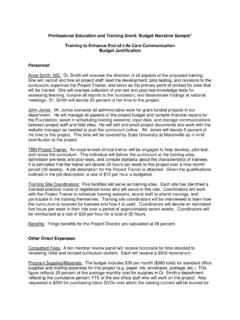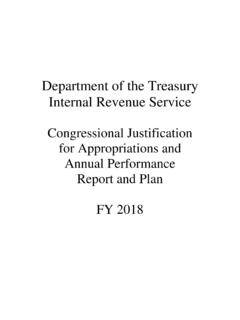Transcription of FY 2019 Budget Justification - fs.fed.us
1 United States Department of Agriculture FY 2019 . Budget Justification Forest Service February 2018. 1. The Department of Agriculture (USDA) prohibits discrimination in all its programs and activities on the basis of race, color, national origin, age, disability, and where applicable, sex, marital status, familial status, parental status, religion, sexual orientation, genetic information, political beliefs, reprisal, or because all or part of an individual's income is derived from any public assistance program. (Not all prohibited bases apply to all programs.). Persons with disabilities who require alternative means for communication of program information (Braille, large print, audiotape, etc.) should contact USDA's TARGET Center at (202) 720-2600 (voice and TDD). To file a complaint of discrimination, write USDA, Director, Office of Civil Rights, 1400 Independence Avenue, , Washington, 20250-9410, or call (800) 795-3272 (voice) or (202) 720-6382 (TDD).
2 USDA is an equal opportunity provider and employer. i FY 2019 Budget Justification Table of Contents Budget Overview .. 1. Legislative 3. Administrative Provisions .. 4. General Provisions .. 6. Purpose Statement .. 9. Four-Year Summary of Appropriations .. 10. Four-Year Summary of Full Time Equivalents .. 13. Revenue, Receipts and Transfers .. 15. Organization Chart .. 16. Available Funds and Staff Years (SYs).. 17. Motor Vehicle Fleet Data .. 18. Permanent Positions by Grade and Staff Years .. 20. Shared Funding 21. Summary of Performance .. 23. Forest and Rangeland Research .. 27. Appropriations Language and Explanation of Changes .. 27. Lead-Off Tabular Statement .. 27. Project Statements .. 28. Justifications .. 30. Classification by Objects .. 34. Status of Programs .. 35. Primary Authorities .. 37. State and Private Forestry .. 41. Appropriations Language and Explanation of Changes .. 41. Lead-Off Tabular Statement.
3 41. Project Statements .. 42. Justifications .. 44. Classification by Objects .. 50. Status of Programs .. 51. Primary Authorities .. 59. National Forest System .. 61. Appropriations Language and Explanation of Changes .. 61. Lead-Off Tabular Statement .. 61. Project Statements .. 62. Justifications .. 64. Classification by Objects .. 72. Status of Programs .. 73. Primary Authorities .. 83. ii Capital Improvement and Maintenance .. 89. Appropriations Language and Explanation of Changes .. 89. Lead-Off Tabular Statement .. 89. Project Statements .. 90. Justifications .. 92. Classification by Objects .. 95. Status of Programs .. 96. Primary Authorities .. 99. Land Acquisition .. 101. Appropriations Language and Explanation of Changes .. 101. Lead-Off Tabular Statement .. 101. Project Statements .. 102. Justifications .. 104. Classification by Objects .. 106. Status of Programs .. 107. Primary Authorities.
4 108. Other Appropriations .. 109. Appropriations Language and Explanation of Changes .. 109. Lead-Off Tabular Statement .. 109. Project Statements .. 110. Justifications .. 111. Classification by Objects .. 113. Status of Programs .. 114. Primary Authorities .. 115. Wildland Fire Management .. 117. Appropriations Language and Explanation of Changes .. 117. Lead-Off Tabular Statement .. 118. Project Statements .. 119. Justifications .. 121. Classification by Objects .. 124. Status of Programs .. 125. Primary Authorities .. 130. Permanent Appropriations .. 133. Lead-Off Tabular Statement .. 133. Project Statements .. 134. Status of Programs .. 136. Payments to States .. 144. Trust Funds .. 147. Lead-Off Tabular Statement .. 147. Project Statements .. 147. Status of Programs .. 148. iii Special Exhibits .. 151. Biomass and Wood Innovations .. 151. California Tree Mortality .. 154. Chief's Reserve Fund .. 156.
5 Cost Pool Totals .. 158. Equal Access to Justice 163. Farm Bill Implementation .. 175. Fire Transfers .. 178. National Scenic and Historic Trails .. 180. Office of General Counsel 184. Region, Station, and Area Allocations .. 185. Research and Development Field Unit Budget 197. Stewardship Contracting .. 218. Transition to Second Growth in Alaska .. 221. Unobligated Balances .. 222. USDA Working Capital Fund, Departmental Shared Cost Programs .. 224. Forest Service - Working Capital Fund .. 228. iv This page intentionally left blank. v Budget Overview The greatest good for the greatest number in the long run.. Gifford Pinchot, first Chief of the Forest Service (1905-1910). Mission The USDA Forest Service's mission is to sustain the health, diversity, and productivity of the Nation's forests and grasslands to meet the needs of present and future generations. USDA Forest Service Priorities - In FY 2019 , the Forest Service aligned its strategic and programmatic direction to address the risks and challenges the agency faces, and to support the broader Administration goals to maintain focus on the maintenance of the current National Forest System (NFS) lands, protect the nation's interests from the impacts of wildland fire, share stewardship of the land, promote recreational access and opportunities on NFS lands, and generate jobs and economic benefits for rural communities.
6 These priorities support USDA Strategic Goal 6: Ensure Productive and Sustainable Use of our National Forest System Lands. To ensure progress towards achieving the broader goals, five national priorities help guide Forest Service execution of the agency mission: Uplift and empower Forest Service employees through a respectful, safe working environment. Be a good neighbor and provide excellent customer service. Promote shared stewardship by increasing partnerships and volunteerism. Improve the condition of forests and grasslands. Enhance recreation opportunities, improve access, and sustain infrastructure. Budget Overview The 2019 Forest Service Budget for discretionary appropriations is $ billion, a decrease of $486 million from the FY 2018 annualized Continuing Resolution amount. It includes $ billion for the management of National Forest System lands and $ billion for Wildland Fire Management. Maintaining fiscal integrity of the agency while focusing on Administration goals and priorities required reductions in funding to Capitol Improvement and Maintenance, Research, Land Acquisition and State and Private Forestry Programs.
7 Jobs and Economic Contribution The FY 2019 Budget proposal maintains significant Forest Service economic investment, benefitting many rural forest and grassland dependent communities and the nation as a whole. The Forest Service projects, based on most recent estimates, that its proposed program of work will contribute between 340,000 and 370,000 (average annual full-time, part-time, temporary, and seasonal) jobs to the economy and between $30 billion and $31 billion in gross domestic product. This funding aligns with the priority to improve the condition of forests and grasslands and create jobs, and it supports USDA Strategic Goal 6 and its underlying objectives. National Forest System In FY 2019 , the National Forest System Budget is proposed at $ billion, including Hazardous Fuels funding. The significant funding levels in this account are: $390 million proposed for Hazardous Fuels, an increase of $ million from the FY 2018 Annualized Continuing Resolution funding level.
8 The Hazardous Fuels program supports the agency's emphasis on improving the condition of the Nation's forests and grasslands while enhancing their resilience to the negative effects of wildland fire and directly contributes to USDA Strategic Goal 6 and its underlying objectives by furthering the productive and sustainable use of our National Forest System lands. $341 million is proposed for Forest Products a decrease of $24 million from the FY 2018 Annualized Continuing Resolution funding level. Forest Products supports the Administration's commitment to rural communities, jobs creation, shared stewardship, and the production of goods and services from NFS lands. This funding helps forests and grasslands to produce goods and services that people want and need, now and into the future. The Forest Products program supports USDA Strategic Objective : Ensure Lands and Watersheds are Sustainable, Healthy, and Productive.
9 In FY 2019 , the Forest Service will sell billion board feet of timber while improving the ecological condition of more than million acres of NFS lands. The Forest Service is working to improve the speed and agility in the planning and execution of land management actions including timber sales. Timber sales are an important tool for accomplishing resource management objectives in an ecologically and economically efficient manner while generating revenue to offset the costs of implementation, which 1. directly supports USDA Strategic Objective : to Ensure Lands and Watersheds are Sustainable, Healthy, and Productive. $240 million is proposed for Recreation, Heritage, and Wilderness a decrease of $ million from 2018. annualized Continuing Resolution funding level. The Forest Service provides sustainable recreation programs that support rural economies, meaningful outdoor experiences, and improve access. The Forest Service will maximize the return of funding investments by increasing volunteerism, improving customer service, increasing partnerships and working to right size recreation assets.
10 This will encourage new businesses to support outdoor activities which will translate to jobs in rural communities and increase spending by visitors to the national forests, directly supporting USDA Strategic Objective to contribute to the Economic Health of Rural Communities through Use and Access Opportunities. In FY 2019 , the Capital Improvement and Maintenance Budget is nearly $95 million, a decrease of $267. million below the FY 2018 Annualized Continuing Resolution funding level. The FY 2019 President's Budget refocuses the Capital Improvement and Maintenance programs to manage existing infrastructure, primarily NFS passenger roads. Wildland Fire Management In FY 2019 , the Wildland Fire Management Budget is proposed at $ billion, an increase of $190 million above the FY 2018 Annualized Continuing Resolution funding level. Wildland Fire Management remains a top priority in the Forest Service and aligns with USDA Strategic Objective : Mitigate Wildfire Risk while contributing to overall accomplishment of USDA Strategic Goal 6.












